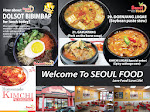Eating the Korean Way
When dining with Korean friends or a family, it is good manners to wait until the older people at the table have picked up their spoons or chopsticks before you begin eating. Most Koreans don't use knives or forks. Food is cut into bite-sized pieces before it is served. All the food is placed on the table at once and Koreans eat out of bowls, not plates.
Traditionally, the entire family ate breakfast together, the main meal of the day. Today, because of industrialization and an increasingly western lifestyle, dinner has become the largest meal of the day.
Korean meals include soup or kuk and rice or pap. These are served with highly seasoned side dishes such as banchan made of vegetables, beef, chicken, pork or fish. Thick stews made with meat, potatoes, onions, bean curd and zucchini, seasoned with sesame oil, garlic, pepper and bean or red pepper paste are called chigae.
A popular and common staple of every Korean meal is a fermented spicy pickle called kim chi. Kim chi is made with Chinese cabbage, paechoo, and radishes or cucumbers that are soaked in salt water. Later the vegetables are seasoned with garlic, onions, ginger, chilies and salted fish granules. In urban households, the vegetables are stored in vacuum jars and kept in the refrigerator or a cool dark place for at least one month. Cooks in the Korean countryside store kim chi in clay pots and bury them in the ground to ferment.
Teas made from ginseng, ginger and green tea are popular hot drinks. Favourite cold drinks are made with sweet persimmon or cinnamon and flavoured with honey. Traditional Korean foods usually eaten at holidays are sweet and sticky rice cakes that may be flavoured with red bean jelly, nuts or fruit. Cookies made from rice, beans and sesame seeds held together with molasses are also favourite treats.
Here is a recipe for you to try:
Kim Chi
Ingredients
1 head of Chinese cabbage
1-2 cloves of garlic
2 green onions
2 tsp Korean red pepper powder
1 tsp grated ginger
salt or sawoojub - this is available at Korean grocery stores and means salty, little shrimp.
Preparation
Chop the cabbage, onions and garlic, and mix with pepper powder, ginger and salt or sawoojub (salty fish). Put in a jar.
Tuesday, April 27, 2010
Wednesday, April 21, 2010
Kimchi(김치)

Kimchi, characterized by its spicy taste and crispiness, is the most well-known Korean dish. Depending on the fermentation process, ingredients, region and weather, the taste of kimchi changes, which is why there are over 200 types of kimchi. According to Health magazine, kimchi is one of the world's healthiest foods. Health described it as "loaded with vitamins A, B, and C, but its biggest benefit may be in its "healthy bacteria" called lactobacilli, found in fermented foods like kimchi and yogurt. This good bacteria helps with digestion, plus it seems to help stop and even prevent yeast infections, according to a recent study. And more good news: Some studies show fermented cabbage has compounds that may prevent the growth of cancer."
Gochujang(고추장)

Gochujang(Korean chili paste) is made from dried Korean chilies, salt, water, fermented soybeans and sweet rice powder. These ingredients are thoroughly mixed then fermented to enhance the spiciness of the sauce. Many people like to mix gochujang and sesame oil with rice. This paste is also used as a dip for vegetables.
Tuesday, April 20, 2010
Saturday, April 17, 2010
Subscribe to:
Posts (Atom)















